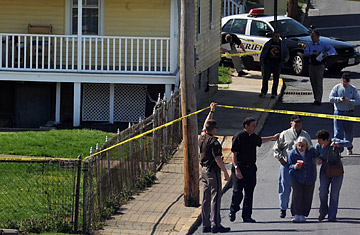
A priest comforts people walking next to the house in Middletown, Md. on Saturday, April 18, 2009 where five bodies were found.
On March 30, a Santa Clara, Calif., man shot five people to death, including three children, before killing himself. On April 3, a gunman went on a shooting rampage in an immigration center in Binghamton, N.Y., killing 13 people before taking his own life. And on April 20, employees of a Sheraton Hotel in Maryland found the bodies of a husband and wife and two daughters, victims of another apparent murder-suicide.
These are only the most publicized of the recent murder-suicide crimes in the U.S. Since March 10, 2009, at least 43 people have been killed in murder-suicides, and there is no telling why the crimes occurred in such rapid succession. It is also not clear whether the spate of recent deaths represents an escalation in the typical murder-suicide death toll. But it has got some observers wondering why. Past research suggests that factors ranging from the time of year (suicides are more common in spring) to the financial climate may have an impact on the rates of suicide and murder; in the recent events, the apparent motive of the killers included sexual jealousy and economic despair. (See pictures of the shooting in Binghamton.)
But Steven Stack, professor of psychiatry and criminal justice at Wayne State University, offers another explanation: the copycat effect. The copycat theory was first conceived by a criminologist in 1912, after the London newspapers' wall-to-wall coverage of the brutal crimes of Jack the Ripper in the late 1800s led to a wave of copycat rapes and murders throughout England. Since then, there has been much research into copycat events — mostly copycat suicides, which appear to be most common — but, taken together, the findings are inconclusive.
In a 2005 review of 105 previously published studies, Stack found that about 40% of the studies suggested an association between media coverage of suicide, particularly celebrity suicide, and suicide rates in the general public. He also found a dose-response effect: The more coverage of a suicide, the greater the number of copycat deaths. (See pictures of an exhibit of Columbine evidence.)
But 60% of past research found no such link, according to Stack's study. He explains that the studies that were able to find associations were those that tended to involve celebrity death or heavy media coverage — factors that, unsurprisingly, tend to co-occur. "The stories that are most likely to have an impact are ones that concern entertainment and political celebrities. Coverage of these suicides is 5.2 times more likely to produce a copycat effect than coverage of ordinary people's suicides," Stack says. In the month after Marilyn Monroe's death, for example, the suicide rate in the U.S. rose by 12%.
Stack also conducted the only study to examine whether murder-suicide (as opposed to suicide alone) is associated with copycat crimes. That study, published 20 years ago, analyzed the impact of media coverage of mass murders and murder-suicides between 1968 and 1980. The study found no associated increase in homicide rates, but did note an uptick in suicide after well-publicized events. "There was a significant increase in national monthly suicide rates," he said, "It is a fairly substantial association and was independent of major control variables like the unemployment rate."
For now, it seems that the reason behind the recent series of murder-suicides will remain unclear, but whether it's the economy, the season, gun availability or copycatting, it will be no simple task figuring out how to stop them.
